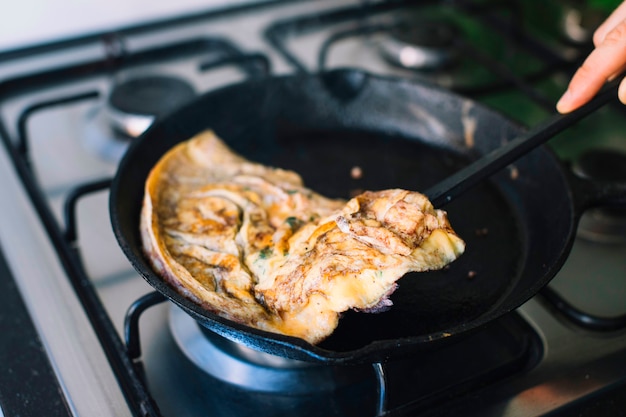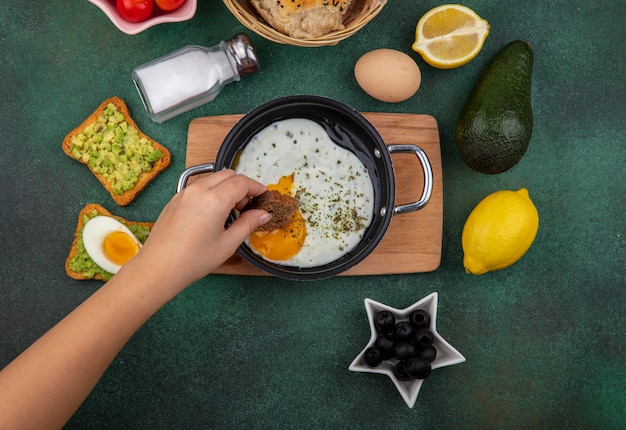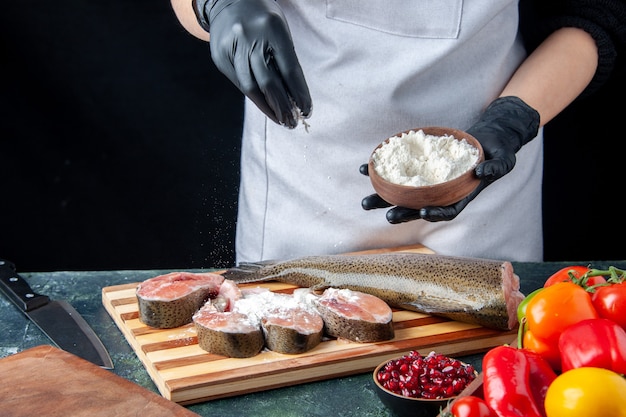Let’s face it, tripe. It’s not exactly the most glamorous ingredient, is it? The mere mention of it conjures up images of… well, let’s just say it’s not everyone’s cup of tea. But trust me, my culinary adventurers, tripe is a hidden gem waiting to be unearthed. It’s bursting with flavour, incredibly versatile, and surprisingly affordable. So, ditch those preconceived notions and let me guide you on a journey to tripe triumph!
(Part 1) What is Tripe?

Tripe, at its core, is the stomach lining of various animals, most commonly cattle, sheep, or pigs. Sounds a bit… off-putting, right? But remember, we're used to eating heart, liver, kidneys, and other parts of animals – why not give tripe a chance?
The Different Types of Tripe
The world of tripe is actually quite diverse. There are three main types, each with its unique texture and best uses:
- Honeycomb tripe: This is the most common variety, known for its distinctive honeycomb-like structure due to its muscular makeup. It's a fantastic base for hearty stews and soups, lending a rich, meaty flavour.
- Book tripe: This type, originating from the second stomach chamber of cattle, has a smooth, almost book-like appearance. It's often the preferred choice for stir-fries and curries, adding a satisfying chewiness to the dish.
- Blanket tripe: The smooth, fleshy lining of the rumen, blanket tripe offers a tender texture. It excels in casseroles and pies, contributing a substantial base to these comforting dishes.
Tripe's Nutritional Value
Don't underestimate the nutritional punch of tripe! It's a fantastic source of protein, iron, and zinc, and surprisingly low in fat and calories. So, it's not just delicious, but a healthy addition to your diet.
(Part 2) Sourcing Your Tripe

Now, you might be wondering where you can find this culinary treasure. Fear not, tripe is gaining popularity! You can find it in:
- Butchers: Most reputable butchers will have tripe in stock, and they are often happy to share their expertise on preparing it. So, don't hesitate to ask!
- Ethnic Markets: Ethnic markets are excellent sources for a wider variety of tripe, including different cuts and preparations that cater to specific culinary traditions. It's a great place to explore new tripe-based dishes.
- Online Retailers: For those who prefer online shopping, you can find a range of suppliers offering tripe. Just be sure to check reviews to ensure you're choosing a reputable source.
(Part 3) Preparing Your Tripe: A Culinary Transformation

Tripe isn’t exactly a "ready-to-eat" ingredient. It needs a bit of pre-treatment to transform it from its raw state into a delicious culinary delight.
Cleaning the Tripe: A Crucial Step
Cleaning tripe might seem intimidating, but it’s actually a straightforward process:
- Rinse it thoroughly under cold running water to remove any debris or loose particles. You want to start with a clean slate!
- Remove any visible fat or membranes with a sharp knife. This step ensures a cleaner taste and texture.
- Soak the tripe in cold water for at least 30 minutes, changing the water every 15 minutes. This helps remove any lingering impurities.
- Boil the tripe for about 30 minutes in fresh water. This final step further purifies the tripe, leaving it ready for your culinary creations.
Cutting the Tripe: Getting Ready to Cook
Once your tripe is clean, you can cut it into the desired size for your recipe. Honeycomb tripe, for instance, can be cut into strips, cubes, or even smaller pieces depending on the dish.
(Part 4) Cooking Tripe: Unleashing the Flavours
Tripe is incredibly versatile, lending itself to a variety of cooking methods. Here's a breakdown of some popular techniques:
Braising: Tenderizing and Enhancing Flavour
Braising is a fantastic way to tenderize tripe and infuse it with rich flavours. Start by browning the tripe in a pan with some oil, then transfer it to a pot with your chosen braising liquid – be it stock, wine, or beer. Cook it slowly until tender, allowing the flavours to meld and create a symphony of taste.
Stewing: Hearty and Soul-Satisfying
Tripe is a true star in hearty stews. Cook it alongside an assortment of vegetables and meats for a truly flavour-packed dish. The long, slow simmering process allows the tripe to absorb the delicious flavours of its companions.
Frying: A Crispy Delight
You can also achieve a delightful crispy texture by frying tripe quickly in a pan. This is an excellent method for stir-fries or as a side dish. The crispy exterior contrasts beautifully with the tender interior.
Adding Flavour: Unleashing Tripe's Potential
The key to truly amazing tripe dishes lies in layering on the flavour. Experiment with:
- Herbs and spices: Bay leaves, thyme, rosemary, garlic, ginger, paprika, cumin, and curry powder are all wonderful companions for tripe. These aromatic additions can transform a simple dish into a culinary masterpiece.
- Vinegar: A splash of vinegar adds a touch of brightness and depth to tripe dishes, balancing the richness and creating a more complex flavour profile.
- Tomato products: Tomatoes, tomato paste, and tomato sauce add a sweet and tangy dimension to tripe dishes, complementing their meaty character.
(Part 5) Tripe Recipes: A Culinary Adventure Awaits
Enough with the theory! Let's dive into some delicious tripe recipes that will change your perception of this overlooked ingredient.
1. Classic Tripe Stew (British Style)
This comforting dish is a true testament to British home cooking. It's simple, hearty, and packed with flavour.
Ingredients:
- 1 kg honeycomb tripe, cleaned and cut into 2-3 cm cubes
- 1 tbsp olive oil
- 1 large onion, chopped
- 2 carrots, chopped
- 2 celery stalks, chopped
- 2 cloves garlic, minced
- 1 tbsp plain flour
- 500 ml beef stock
- 1 tsp dried thyme
- 1 bay leaf
- Salt and pepper to taste
Instructions:
1. Heat the olive oil in a large pot over medium heat. Add the onion, carrot, and celery and cook until softened, about 5-7 minutes.
2. Add the garlic and cook for another minute.
3. Stir in the flour and cook for another minute.
4. Add the tripe, beef stock, thyme, and bay leaf. Bring to a boil, then reduce heat and simmer for 1-1.5 hours, or until the tripe is tender.
5. Season with salt and pepper to taste. Serve hot with crusty bread.
2. Tripe with Tomato and Olives (Mediterranean Style)
This vibrant Mediterranean-inspired dish showcases the best of sun-kissed flavours.
Ingredients:
- 1 kg honeycomb tripe, cleaned and cut into strips
- 2 tbsp olive oil
- 1 large onion, chopped
- 2 cloves garlic, minced
- 400 g chopped tomatoes
- 100 g pitted black olives, halved
- 1 tsp dried oregano
- 1/2 tsp red pepper flakes
- Salt and pepper to taste
- Chopped fresh parsley, for garnish
Instructions:
1. Heat the olive oil in a large pan over medium heat. Add the onion and cook until softened, about 5 minutes.
2. Add the garlic and cook for another minute.
3. Stir in the tripe, chopped tomatoes, olives, oregano, and red pepper flakes.
4. Bring to a boil, then reduce heat and simmer for 30 minutes, or until the tripe is tender.
5. Season with salt and pepper to taste.
6. Garnish with chopped fresh parsley and serve with crusty bread.
3. Tripe Stir-fry with Ginger and Garlic (Asian Style)
This quick and flavourful dish offers a taste of Asian culinary magic.
Ingredients:
- 500 g book tripe, cleaned and cut into thin slices
- 2 tbsp soy sauce
- 1 tbsp oyster sauce
- 1 tbsp cornstarch
- 1 tbsp sesame oil
- 1 tbsp vegetable oil
- 2 cloves garlic, minced
- 1 inch ginger, minced
- 1 red bell pepper, sliced
- 1 green bell pepper, sliced
- 1 cup broccoli florets
- 1/2 cup chopped scallions
Instructions:
1. In a bowl, combine the tripe with soy sauce, oyster sauce, and cornstarch. Marinate for at least 30 minutes.
2. Heat the sesame oil and vegetable oil in a large wok or pan over high heat.
3. Add the garlic and ginger and cook for 30 seconds.
4. Add the tripe and cook until browned on both sides, about 5 minutes.
5. Add the bell peppers, broccoli, and scallions and cook until the vegetables are tender-crisp, about 3 minutes.
6. Serve immediately over rice or noodles.
4. Tripe and Potato Hash (Hearty and Rustic)
This hearty and satisfying dish is perfect for a comforting meal.
Ingredients:
- 500 g honeycomb tripe, cleaned and cut into 1 cm cubes
- 1 tbsp olive oil
- 1 large onion, chopped
- 2 cloves garlic, minced
- 1 kg potatoes, peeled and diced
- 1/2 cup chicken stock
- Salt and pepper to taste
- Fresh herbs (parsley, chives), for garnish
Instructions:
1. Heat the olive oil in a large pan over medium heat. Add the onion and cook until softened, about 5 minutes.
2. Add the garlic and cook for another minute.
3. Stir in the tripe and potatoes. Cook for about 5 minutes, stirring occasionally.
4. Pour in the chicken stock and bring to a boil. Reduce heat and simmer for 15-20 minutes, or until the potatoes are tender and the tripe is cooked through.
5. Season with salt and pepper to taste. Garnish with fresh herbs and serve hot.
(Part 6) Tripe Tips: Mastering the Art of Tripe
Now that you're armed with some delicious recipe inspiration, here are some insider tips to elevate your tripe cooking game:
1. Choosing the Right Tripe: A Visual Guide
Look for tripe that is firm to the touch and has a pale pink or greyish colour. Avoid tripe that is discoloured, has a strong odour, or feels slimy. It’s all about selecting quality ingredients!
2. Cleaning is Key: Ensuring a Delicious Outcome
Cleaning the tripe thoroughly is essential to remove any unpleasant taste or odour. Don't skip the soaking and boiling steps, as they play a vital role in creating a delicious final dish.
3. slow cooking is Your Friend: Achieving Tenderness
Tripe takes time to cook and become tender. Don't rush the process! low and slow cooking is the key to unlocking the best texture and flavour.
4. Don't Be Afraid to Experiment: Creating Your Signature Dishes
Tripe is incredibly versatile, so don't be afraid to experiment with different spices, herbs, and ingredients to create your own signature dishes. There’s no right or wrong way to cook with tripe, just let your creativity flow!
5. Embrace the Texture: A Unique Culinary Experience
Tripe has a unique texture that some people might find unusual. But embrace it! The chewy, slightly rubbery texture is part of what makes tripe so special. It adds a satisfying element to the dishes.
(Part 7) Tripe Around the World: A Global culinary journey
Tripe is a beloved ingredient in countless cultures across the globe, each with its own unique take on this versatile delicacy.
1. Tripe in Britain: A Classic comfort food
In Britain, tripe is often used in traditional stews, soups, and pies. Tripe and onions is a classic comfort food, while tripe and brains is a more traditional offering.
2. Tripe in Spain: A Culinary Treasure
Spain is famous for its tripe dishes, particularly "callos a la madrile??a," a hearty stew made with tripe, chickpeas, chorizo, and aromatic spices.
3. Tripe in Italy: A Roman Delight
In Italy, tripe is often used in "trippa alla romana," a dish featuring tripe cooked with tomatoes and topped with grated Parmesan cheese.
4. Tripe in Asia: A Versatile Ingredient
Tripe is a popular ingredient in Asian cuisine, frequently used in stir-fries, curries, and soups. In Korea, for instance, tripe is often braised with kimchi, creating a complex and flavorful dish.
5. Tripe in South America: A Hearty Stew
In South America, tripe is often the star of "mondongo," a hearty stew made with tripe, vegetables, and meat. It's a true testament to the diverse culinary traditions of the region.
(Part 8) FAQs: Your Tripe Questions Answered
Here are some frequently asked questions about tripe, ensuring you have all the information you need to embark on your culinary adventure.
1. Is tripe safe to eat?
Yes, tripe is safe to eat when properly cleaned and cooked. It's a good source of protein and other essential nutrients, making it a healthy addition to your diet.
2. How can I tell if tripe is fresh?
Fresh tripe is firm to the touch, has a pale pink or greyish colour, and has no strong odour. Avoid tripe that is discoloured, slimy, or has a foul smell. It’s all about choosing quality ingredients!
3. Can I freeze tripe?
Yes, you can freeze tripe. Clean it thoroughly, then freeze it in a freezer-safe bag. Thaw it in the refrigerator overnight before cooking.
4. How long does tripe take to cook?
Tripe takes a long time to cook, typically 1-2 hours, depending on the cut of tripe and the cooking method. Patience is key to unlocking the best texture and flavour.
5. What are some good side dishes for tripe?
Crusty bread, mashed potatoes, rice, or noodles are all delicious accompaniments for tripe. You can also serve it with a simple salad for a refreshing contrast.
(Part 9) Tripe: A Culinary Adventure Awaits
Cooking with tripe is a culinary adventure, a journey of discovery, a challenge to your preconceived notions, and a chance to experience a new world of flavour. Embrace the adventure, get your tripe, follow the tips, and create culinary magic. I promise, you won't be disappointed!
Everyone is watching

Corn on the Cob: The Ultimate Guide to Perfectly Cooked Ears
Healthy MealsAh, corn on the cob. Just the name evokes images of sunny days, barbecues, and that sweet, juicy flavour that ...

Scallops: The Ultimate Guide to Perfect Cooking
Healthy MealsAh, scallops. Those delicate, sweet, and utterly delicious morsels of the sea. They hold a special place in my...

Spaghetti Squash: The Ultimate Guide to Cooking and Serving
Healthy MealsRemember that time you saw spaghetti squash at the supermarket, looking all bumpy and strange, and thought, "W...

Salmon Cooking Times: Perfect Guide for Every Recipe
Healthy MealsLet me tell you, cooking salmon is an art form. It's all about getting that perfect balance: juicy and tender,...

Ham Cooking Time: How Long to Bake, Smoke, or Boil a Delicious Ham
Healthy MealsAh, ham. It's a classic, isn't it? A real crowd-pleaser, especially around holidays. And when done right, it'...
